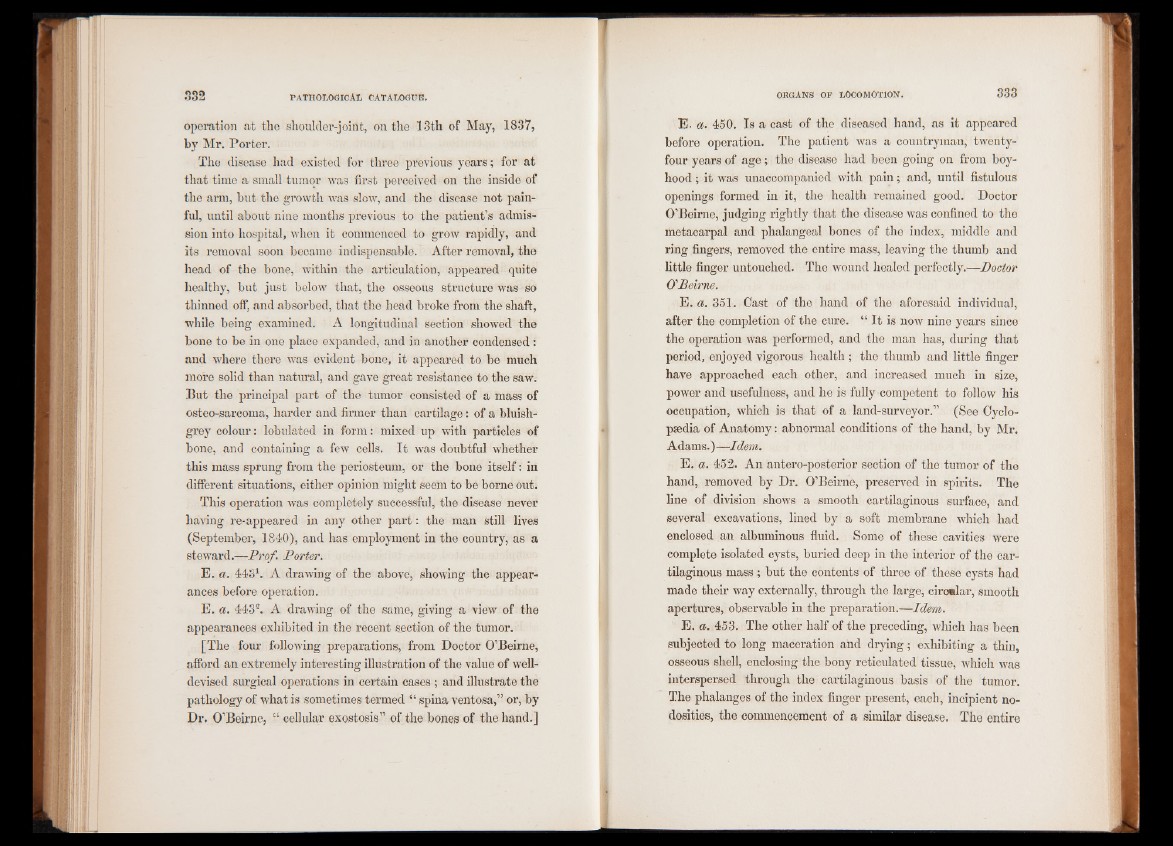
operation at the shoulder-joint, on the 13th of May, 1837,
by Mr. Porter.
The disease had existed for three previous years; for at
that time a small tumor was first perceived on the inside of
the arm, but the growth was slow, and the disease not painful,
until about nine months previous to the patient’s admission
into hospital, when it commenced to grow rapidly, and
its removal soon became indispensable. After removal, the
head of the bone, within the articulation, appeared quite
healthy, but just below that, the osseous structure was so
thinned off, and absorbed, that the head broke from the shaft,
while being examined. A longitudinal section showed the
bone to be in one place expanded, and in another condensed :
and where there was evident bone, it appeared to be much
more solid than natural, and gave great resistance to the saw.
But the principal part of the tumor consisted of a mass of
osteo-sarcoma, harder and firmer than cartilage: of a bluish-
grey colour: tabulated in form: mixed up with particles of
bone, and containing a few cells. It was doubtful whether
this mass sprung from the periosteum, or the bone itself: in
different situations, either opinion might seem to be borne out.
This operation was completely successful, the disease never
having re-appeared in any other part: the man still lives
(September, 1840), and has employment in the country, as a
steward.—Prof. Porter.
E. a. 4431. A drawing of the above, showing the appearances
before operation.
E. a. 4432. A drawing of the same, giving a view of the
appearances exhibited in the recent section of the tumor.
[The four following preparations, from Doctor O’Beirne,
afford an extremely interesting illustration of the value of well-
devised surgical operations in certain cases ; and illustrate the
pathology of what is sometimes termed “ spina ventosa,” or, by
Dr. O’Beirne, “ cellular exostosis” of the bones of the hand.]
E. a. 450. Is a cast of the diseased hand, as it appeared
before operation. The patient was a countryman, twenty-
four years of age; the disease had been going on from boyhood
; it was unaccompanied with pain; and, until fistulous
openings formed in it, the health remained good. Doctor
O’Beirne, judging rightly that the disease was confined to the
metacarpal and phalangeal bones of the index, middle and
ring fingers, removed the entire mass, leaving the thumb and
little finger untouched. The wound healed perfectly.—Doctor
O'Beirne.
E. a. 351. Oast of the hand of the aforesaid individual,
after the completion of the cure. “ It is now nine years since
the operation was performed, and the man has, during that
period, enjoyed vigorous health ; the thumb and little finger
have approached each other, and increased much in size,
power and usefulness, and he is fully competent to follow his
occupation, which is that of a land-surveyor.” (See Cyclopaedia
of Anatomy: abnormal conditions of the hand, by Mr.
Adams.)—Idem.
E. a. 452. An antero-posterior section of the tumor of the
hand, removed by Dr. O’Beirne, preserved in spirits. The
line of division shows a smooth cartilaginous surface, and
several excavations, lined by a soft membrane which had
enclosed an albuminous fluid. Some of these cavities were
complete isolated cysts, buried deep in the interior of the cartilaginous
mass ; but the contents of three of these cysts had
made their way externally, through the large, circmlar, smooth
apertures, observable in the preparation.—Idem.
E. a. 453. The other half of the preceding, which has been
subjected to long maceration and drying; exhibiting a thin,
osseous shell, enclosing the bony reticulated tissue, which was
interspersed through the cartilaginous basis of the tumor.
The phalanges of the index finger present, each, incipient nodosities,
the commencement of a similar disease. The entire